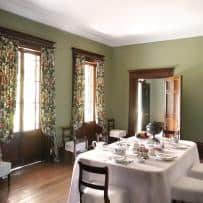 Working as a guide at a historic home sounds, for many people, like a dream job. But is it?
Working as a guide at a historic home sounds, for many people, like a dream job. But is it?
Last year I was lucky enough to meet the lovely Jacky Dalton, who works at Sydney Living Museums.
I subsequently asked her about how she came to be in her job and this is what she told me.
HUMBLE BEGINNINGS
My first connection with Elizabeth Farm was a ghost tour almost 16 years ago, and I immediately felt a connection with the property even though I had no experience, or interest, in colonial history.
My interpretation of a visit to a house museum at that point was the necessity to trawl through overwhelming historic ‘clutter’, and as a sanguine personality with no ability or interest in facts and dates any guided tour offered was torturous.
Please don’t think I am belittling the wonderful work done mainly by volunteers with a genuine love for their sacred sites, we would be lost without them. However with my scant knowledge of Australian history and short attention span I was a lost cause. That is until I stumbled on this wonderful house museum that allowed you to sit on the chairs, open drawers, read letters and lazily stare through the French doors whilst reclining on the chaise lounge in the drawing room.

Returning the following weekend, I offered my services as a volunteer willing to work in the garden or do cleaning and administrative work. However the only option for a volunteer was to lead guided tours for visitors. With great faith in my ability I was given a handbook and invited to follow the other volunteer guides until I felt sufficiently equipped to attempt my own tours. After a month of reading and furious note taking I was ready.
For the next 3 years I volunteered as a guide and began to consume any information on the Macarthur family I could find, (possibly not the best way to learn about colonial history as it tends to provide a fairly narrow approach to the subject), eventually leading me to the Macarthur letters. I also trained other volunteer guides and pursued my own research on the family, resulting in an offer of casual and then part time employment as a guide.
I was now actively involved in the day to day activities including the delivery of school programs and the development and presentation of themed events for adult audiences. I nurtured a growing interest in heritage conservation and cleaning that resulted in the creation of a housekeeping regime and manual for Elizabeth Farm. I took on the role of chief guide for about 12 months, relinquishing that role so that I could once again focus on the presentation of the house and the delivery of immersive programs based on the themes of Jane Austen, 19th century food, soft furnishings and the social customs of colonial Australia.
Another one of my interests was the role of the servants and the how the outbuildings were utilised which culminated in a small exhibition on the women servants of Elizabeth Farm. I also worked at Vaucluse House, Elizabeth Bay House and Rouse Hill House and Farm which provided me with a broader perspective on 19th century Australia that motivated me to enrol at the University of New England to pursue an Advanced Diploma in Local, Family and Applied History as a mature aged student – my first attempt at tertiary education at the age of 50.
After 10 years at Elizabeth Farm, the ‘country girl’ finally left to pursue a career at head office in the city, with the occasional trip back for a visit or the delivery of a special program and the opportunity to laze on the chaise lounge.
ACKNOWLEDGEMENTS
My grateful thanks to Jacky Dalton for generously sharing her story.
All photos are of Elizabeth Farm and are sourced from sydneylivingmuseums.com.au/elizabeth-farm

What a wonderful story!
It’s really interesting, isn’t it? Although in the course of my day job I’ve found that asking people (in detail) about their job almost always is. Interesting, I mean.
Sounds like she was learning on the job, and doing a very good job of it too.
Oh yes, she really is very personable and knowledgeable. And generous, to give this information.
Lovely “story” Michelle. Sounds like a chance decision to become a volunteer has turned it a real vocation. I have one little demur though, and that is why Elizabeth Farm is offering programs on Jane Austen? I understand that the era is similar but almost nothing else is, is it – oh yes, they both made quilts! Seriously though … I’d love to know.
I’ll have to ask Jacky and let you know. To hazard a guess, though – Elizabeth Macarthur was only nine years younger than Jane Austen and EM’s English upbringing was was very much that of an Austen character, so the same social mores definitely applied. And if using the words ‘Jane Austen’ brings in extra punters, then who can blame them?
Yes, I realised the age is similar so it makes sense but only just! Recent Jane Austen biographer described Jane Austen as the best known brand in the world – so I do understand. For some Austen aficionados it can sometimes become a little too much, particularly when the event (or whatever who name is being put to) is about the era and not the woman and her work. I’m a bit relaxed about it but I do hope their program is about – or largely about – the literature.